- This text is in Khotanese Saka. (KS 01 from the Berlin-Brandenburgischen Akademie der Wissenschaften in der Staatsbibliothek zu Berlin–Preussischer Kulturbesitz Orientabteilung, published at titus.fkidg1.uni-frankfurt.de/texte/tocharic/tht.htm.)
- The Buddhist temple complex in the ancient city of Gaochang is near Turfan and in the region where Tocharian A appeared.
- The concentric circles of timber posts found at Qäwrighul have been compared with the stone enclosures surrounding Afanasievo burials (see page 51 in this issue).
- A market scene in modern- day Kucha, a city where Tocharian B once flourished.
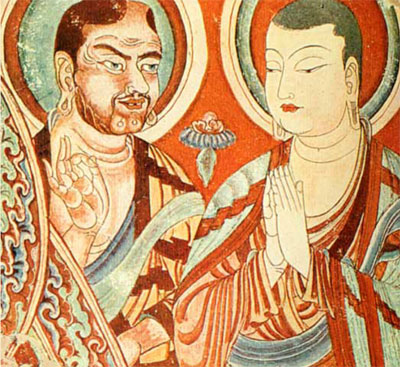
The earliest accounts of the Tarim Basin depict a society whose linguistic and ethnic diversity rivals the type of complexity one might otherwise encounter in a modern transportation hub. The desert sands that did so much to preserve the mummies, their clothes, and other grave goods also preserved an enormous collection of documents, written on stone, wood, leather, or-employing that great Chinese invention-paper. A German expedition to the Tarim Basin in the early 20th century returned with texts in 17 different languages.
We can get some appreciation of the linguistic complexity if we put ourselves in the place of a traveling merchant working the Silk Road in the 8th century CE. A typical trader from the West may have spoken Sogdian at home. He may have visited Buddhist monasteries where the liturgical language would have been Buddhist Hybrid Sanskrit, but the day-to-day language was Tocharian. If his travels took him south to Khotan, he would have to deal in Khotanese Saka. Here, if he had been captured by a raider from the south, he would have had to talk his way out of this encounter in Tibetan or hoped for rescue from an army that spoke Chinese. He could even have bumped into a Jewish sheep merchant who spoke Modern Persian. And if he knew which way the wind was blowing, he would have his sons investing their time in learning Uyghur, the language of a major Turkish tribe who would descend on the Tarim Basin in the 9th century to form its next major ethno-linguistic group.
The many languages of the Tarim Basin can be approached in a variety of ways. Normally, a linguist would first examine them in terms of their genetic relationship by language group. But here, where we are attempting to relate them to the mummies and artifacts of the Bronze and Iron Ages, another approach may be more efficient. Some of the languages were clearly intrusive, derived from outside of the Tarim Basin, and their use was probably confined to certain contexts; others may have been “native” (i.e. spoken over broad areas of the Tarim Basin since the Bronze Age) and, consequently, may have been the spoken languages of the people whose mummified remains have captured so much attention.
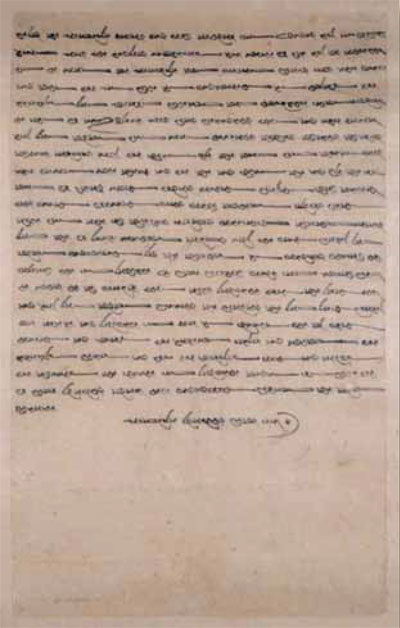
This discussion of languages begins with those that are liturgical, the languages for which we find sacred texts or the accounts of specific religious communities. For example, followers of the Iranian prophet Zarathustra entered the Tarim Basin in the 7th century CE to establish their fire temples in Khotan; they conducted their services in the ancient Iranian language of Avestan. Buddhist missionaries possessed liturgical texts in what is known as Buddhist Hybrid Sanskrit, a language originating in northern India. Sogdian, whose homeland is west Central Asia, was employed not only by merchants but also for the religious documents of Buddhists, Manicheans, and Nestorian Christians. Whether from India or greater Iran, all of these languages were carried into the Tarim Basin by religious communities or merchants from outside the region during the 1st millennium CE.
A second group of languages are associated with documents that were not exclusively religious, but also administrative. This may indicate that the languages were spoken by considerable numbers of the local population. Buddhists in the region of Krorän (Chinese Loulan), for example, employed an Indic language, Prakrit, in administration. Tocharian was used both to translate Buddhist texts and as an administrative language, which suggests that it was spoken by a wider range of people than exclusively monks. Another major language was Khotanese Saka, the language spoken in the south of the Tarim Basin at the site of Khotan as well as at northern sites such as Tumshuq and Murtuq and possibly Qäshqär, the western gateway into the Tarim Basin. The Khotanese texts date to the 7th to 10th century, but they belong to a much wider group of Saka languages spoken across the Eurasian steppe. And unlike Tocharian, which became extinct, there were small pockets of Saka speakers who survived in the Pamir Mountains. Among them are the Sarikoli who relocated to the Tarim Basin to settle near Tashkurgan. Finally, there was a third and obvious ethnolinguistic group that had been established in the region: the Han Chinese. Before the Han Dynasty the Tarim Basin was, according to Chinese history, very much in the huang fu or “wild zone”: the frontier world of fabulous peoples and beasts. We do not begin to obtain good evidence of this region until the Han Dynasty (206 BCE–220 CE), when Zhang Qian made his famous journeys to the west. How much earlier Chinese had settled in the Tarim Basin is estimated by archaeological and anthropological evidence.
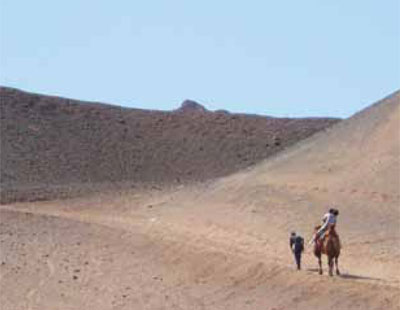
In addition to these major players, the presence of some groups of people can only be confirmed from about the time of the Han Dynasty. These were nomadic peoples who were variously in alliance or confrontation with the world of ancient China. Most formidable were the Xiongnu, the horseriding warriors of the steppe whose repeated attacks prompted the Chinese to build major sections of the Great Wall. The Xiongnu also controlled the Tarim Basin during the 2nd and 1st centuries BCE, until they were finally routed and replaced by the Chinese at the end of the 1st century CE. They left no written records, but if the Xiongnu were the historical Huns, they probably spoke an Altaic language related to Turkish or Mongolian. Among the “peoples of the bow” who were temporarily subjected to the leadership of the Xiongnu were the Wusun; this group settled the northern part of the Tarim Basin in the first centuries CE in a territory previously occupied by Saka tribes.
Once one excludes all the languages imported by foreign missionaries, outside merchants, Chinese administrators, and later Turkic invaders, we are effectively left with two main language groups in the Tarim Basin that might be associated with at least some of the Tarim mummies of the Bronze Age and Iron Age: Khotanese Saka (or any other remnant of the Scythians of the Eurasian steppe) and Tocharian. Of course, totally different languages may have been spoken by these populations, especially if they were derived from native Neolithic groups, whose languages did not survive into the historical record.
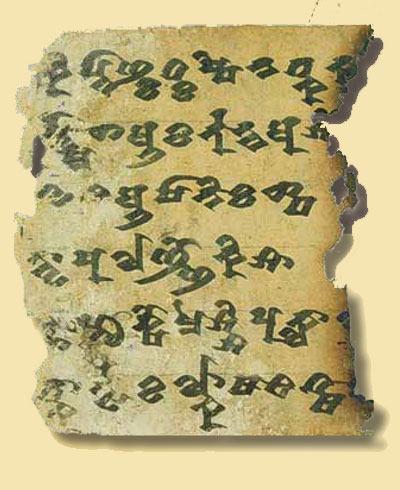
Saka belongs to the eastern branch of the Iranian languages, which was one of the most widespread of the IndoEuropean family of languages spoken in most of Europe, Iran, India, and other parts of Asia. Our primary knowledge of this language group derives from documents from ancient Iran. However, the borders of the language vastly exceeded those of ancient Persia or modern Iran, as it was spread over most of Central Asia and across the Eurasian steppelands from the Danube to the Yenisei River. The sub-branch to which Saka belongs also included Sogdian, Bactrian, and Avestan. Most archaeologists and linguists believe that the Iranian languages appeared earliest in the steppelands and only later moved southward through the agricultural oases of Central Asia into the region of modern Iran. The Iranian language group is very closely related to Indo-Aryan, the branch of Indo-European that occupies the northern two thirds of India; these language groups presumably shared a common origin in the steppe region during the Bronze Age, perhaps about 2500 BCE.
The other major language group in the Tarim Basin is Tocharian, which is subdivided into two languages: Tocharian A, found in documents near Turfan and Qarashähär, and Tocharian B, found mainly around Kucha in the west but also in the same territory as Tocharian A. The documents, dating from the 6th to the 8th centuries CE, suggest that Tocharian A was by that time probably a dead liturgical language, while Tocharian B was still very much in use. In addition to Tocharian, administrative texts have been discovered in Prakrit, an Indian language from the territory of Krorän; these documents contain many proper names and items of vocabulary that would appear to be borrowed from a form of Tocharian (sometimes known as Tocharian C) spoken by the native population. The Kroränian documents date to ca. 300 CE and provide our earliest evidence for the use of Tocharian. For our purposes here, it is also very important to note that the earliest evidence for the mummified remains of “westerners” in the Tarim Basin is found in cemeteries at Xiaohe (Small River) and Qäwrighul, both of which are located in the same region as Tocharian C.
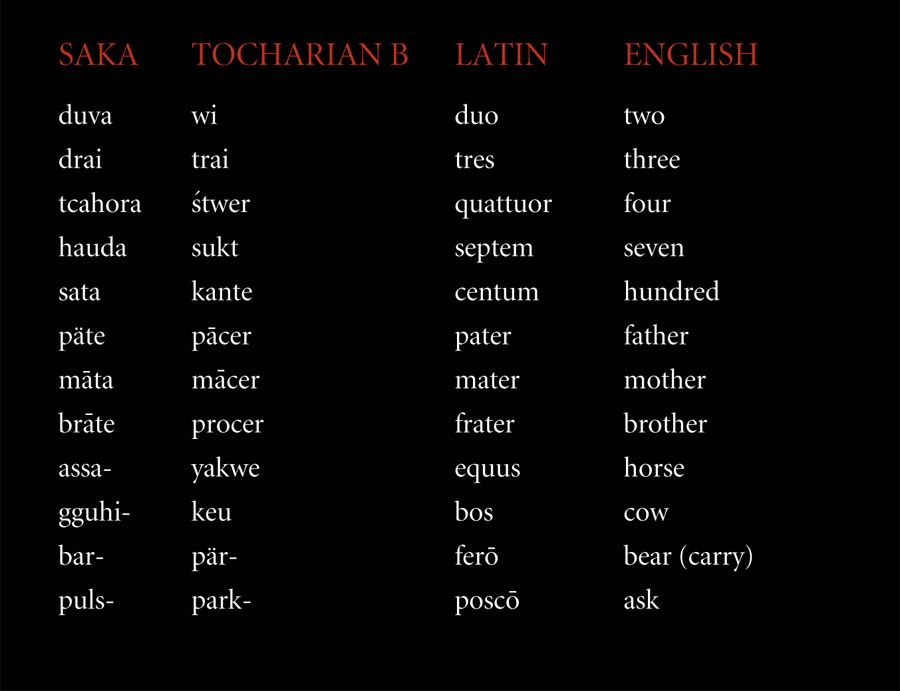
Tocharian documents consist primarily of translations of Buddhist texts, but also include secular documents such as permits for caravans to pass through the territory. Two important features about Tocharian make it stand out among all the languages of the Tarim Basin. The first is that it has no outliers: no evidence of an outside source such as that which can be found for any of the Iranian, Turkish, Chinese, or Tibetan documents. Tocharian is only known in the Tarim Basin. Second, although the Tocharian languages belong to the great Indo-European family of languages, they are not closely related to the only other group of Indo-European languages in greater Asia: the Indo-Iranian languages. Indeed, many linguists prefer to seek out the closest relatives of Indo-Iranian among European languages such as Greek or Germanic, or they argue that Indo-Iranian separated from the rest of the Indo-European world at a very early date. From a linguistic point of view, it is difficult to imagine that the Tocharians originated in the same place and time as Iranian-speaking Saka.
Iranians
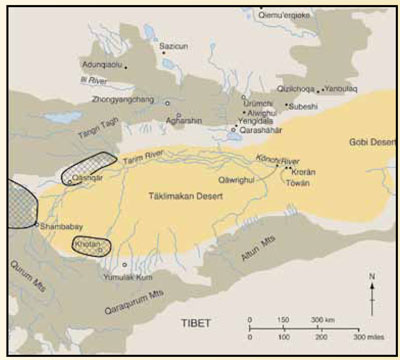

From a linguistic point of view, we need to explain how languages from two major Indo-European language groups managed to spread into the Tarim Basin, and evaluate as far as possible whether they were the languages spoken by those Bronze Age individuals whose remains were mummified. Purely from a geographical perspective, neither language is likely to have entered the Tarim Basin from either the east (where we find Chinese) or the south (Tibetan), thus limiting their approach to either the mountains to the west or the steppes to the north. We also know that the Saka were known to the ancient Greeks as Scythians, and were clearly a people of the northern steppes, famous as horse-riding nomads who periodically challenged the civilizations to their south. They are attested in historical and archaeological sources from about the 8th century BCE, and are identified with ancient regional cultures such as the Tagar of the Minusinsk Basin (8th to 1st century BCE), located to the north of the Tarim, or cemeteries to its west such as Shambabay/Xiangbaobao on the Chinese side of the Pamirs.
Saka cemeteries generally involve inhumation burial within some form of timber chamber—anything from a solid piece of wood to a timber-built chamber—covered by a kurgan or mound. The identification of Saka tombs in the environs of the Tarim Basin itself includes Zhongyangchang in the Tian Shan, where there are about 30 kurgans (ca. 550–250 BCE) attributed to the Saka before the area fell to the Wusun. The site of Alwighul/Alagou is a multi-period and apparently multi-ethnic cemetery; the latest burials (3rd to 2nd century BCE) are assigned to the Saka, as they are found in pine-built chambers and accompanied with animal-style art famous from Scythian/Saka tombs across the Eurasian steppe. On the Keriya River we have both the fortified settlement of Yumulak Kum/Yuansha and adjacent cemeteries. One of the cemeteries goes back to the 7th century BCE and is believed to have been associated with the Saka, based on evidence including timber-built tombs, high peaked hats, Europoid physical type, and Saka-compatible pottery. In terms of distribution, the Saka sites tend to lie to the north, east, or south of where most of the mummified remains have been recovered; however, they have also been identified among the later burials at Alwighul. The tall hats of the female mummies from Subeshi might also pass for a Saka trait, and so identification of some of the mummies with the Saka or Iranian speakers in the northeast Tarim is a serious possibility. But here we are dealing with people and languages which, if our archaeological identifications can be trusted, date only to the last half of the 1st millennium BCE. Can we determine an earlier date for Iranian speakers in the Tarim?
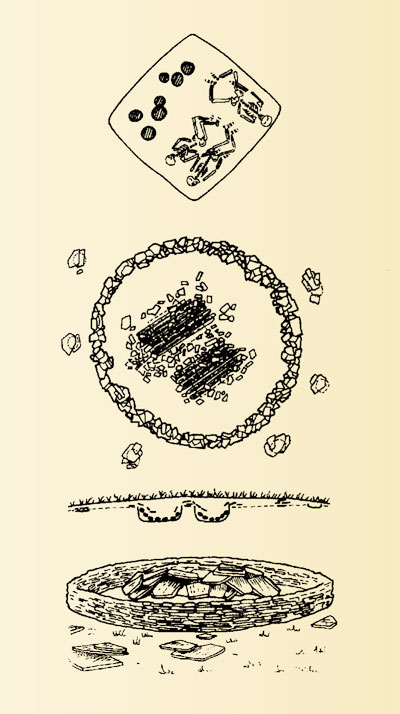

The Bronze Age antecedent to the Iron Age Scythians/Saka is the Andronovo cultural complex, a series of related cultures that spanned the area between the Urals and the Yenisei from ca. 2000–900 BCE. Its linguistic identification is somewhere within the general Indo-Iranian branch of languages and, at least within the steppeland regions, it is presumably Iranian before the 1st millennium BCE. The Andronovo cultural complex provides a broad umbrella of cultural traits which importantly include the use of tin bronze, an extensive series of characteristic metal implements and ornaments, the use of chariots, and distinctive horse-gear. Economically, the culture was versatile: in some regions, it was clearly semi-nomadic, while in others, it adopted irrigation agriculture. Its presence is attested in the Jungghar/ Zhunge’er Basin at cemeteries at Sazicun and Adunqiaolu, where the ceramics are clearly related to the Andronovo complex. People associated with this cultural complex may have lived in the Tarim Basin, although the evidence is strongly circumstantial. We do not have clear examples of Andronovo settlements marked by its distinctive ceramic styles. While some of its burials share what may be generic elements with those found in the Tarim—use of timber chambers or stone cists—the Andronovo type of east Kazakhstan, the Fedorovo culture, practiced cremation as well as inhumation.
In short, direct evidence for Andronovo sites is so far absent from the Tarim Basin. It must be noted that Andronovo metalwork has been recovered from a number of sites, e.g. Xintala, Qizilchoqa, and Yanbulaq as well as the Agarshin hoard from Toquztar. In addition, the initial appearance of horses and wheeled vehicles in the Tarim, and the introduction of the chariot to China, are all attributed to Andronovo contacts. This evidence dates from ca. 1300 BCE onwards and advances considerably the potential presence of Iranian speakers in the Tarim, although it does not provide us with the settlements and burials that might better constitute a “smoking gun.”
Tocharians
The one language group that is most clearly anchored in the Tarim, Tocharian, lacks any obvious external source. So the line of reasoning that might link linguistic evidence with the archaeological record becomes even more dubious. To render matters even more difficult, Iranian speakers from the Andronovo culture of the Iron Age could enter the Tarim Basin from both the north and the west, so this would seem, at first, to remove any potential homeland for the Tocharians since they should not have come from precisely where we derive another language group. There are two ways out of this problem. The first involves suggesting a long and untraceable trek across the Eurasian steppe to the Tarim Basin. As the Andronovo culture is sister to the Timber-grave culture of the European steppe— also seen as the antecedent to Iranianspeakers—this trek would have to start somewhere to the west of the Dnieper and would rival prehistoric journeys such as the migration of southern Athabascans from Canada to the American Southwest. Such an extraordinary historical event is rarely the type of solution that is likely to satisfy either archaeologists or linguists.
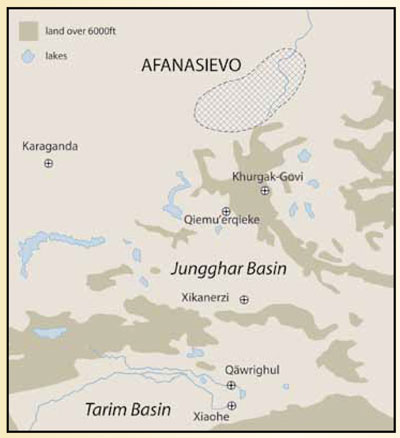
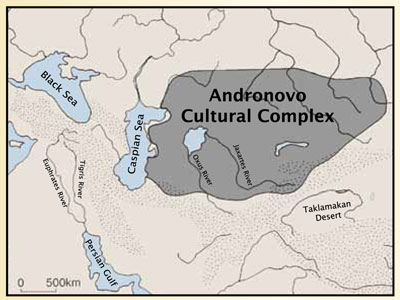
The alternative approach is to select a staging area much closer to the Tarim Basin that predates any of the proposed Iranian-associated migrations. One culture that might fit the bill is the Afanasievo culture of the Altai and Minusinsk regions. This was an Early Bronze Age culture which may have appeared before 3000 BCE (the start date is a serious problem) and continued to ca. 2500 BCE. The Afanasievo is known from settlements that practiced both cereal agriculture and the raising of domestic livestock; however, most evidence of this culture comes from about 50 cemeteries. The Afanasievo burials are in pits, either single or collective, surrounded by stone enclosures, both rectangular and circular. Grave goods include ceramics that are generally decorated over much of their body; shapes are large pointed base vessels and small footed vessels that have been interpreted as censers for burning either an aromatic or hallucinogenic substance. The Afanasievo culture is linguistically attractive because its own antecedents appear to lie in the European steppe, the same region that provides the point of departure for the Indo-Iranian expansion some thousand years later. This provides a convenient explanation for why the Tocharian languages are ultimately related to Indo-Iranian as members of the Indo-European language family, but also as to why they are very different, in that they separated from the rest of the Indo-Europeans at an early date. Admittedly, this still requires an enormous trek from the Volga-Ural region east to the Yenisei with very little evidence of intermediate “stop-overs” other than an Afanasievo cemetery near Karaganda.
The Afanasievo culture apparently expanded to the south. Recent excavations by Alexei Kovalev and Diimaajav Erdenebaatar have uncovered Afanasievo burials in northwest Mongolia at the site of Khurgak-Govi that date to ca. 3000–2500 BCE. Of great importance was the discovery of the remains of a wheeled vehicle in one of the graves. Before this, the only evidence that the Afanasievo culture possessed vehicles was found engraved on stones within their cemeteries. Also, in the foothills of the Jungghar Basin— the natural approach to the Tarim Basin from the north— we find the Qiemu’erqieke (Turkish Shamirshak) culture. Although so far not precisely dated, this culture’s ceramics (both pointed base vessels and footed ones) are similar to those known in the Afanasievo, and here too graves may be marked off with rectangular stone enclosures. Another linking trait is that some of the burials lie on their backs but with their legs flexed: this peculiar posture is also known both in the Afanasievo culture and among the burials of the European steppelands, but it is very rare anywhere else. Similarly, the footed bowls—interpreted as lamps in China but as “censers” in the Afanasievo culture—are also linked to the east European steppe. Finally, the Qiemu’erqieke, Afanasievo, and European steppe cultures all share a tradition of erecting stone anthropomorphic stelae. Although the Qiemu’erqieke is located in the far north of the Jungghar Basin, similar pottery has been recovered from the site of Xikan’erzi, not far from both Ürümchi and the territory of the Tocharians.

Further Afanasievo influence is difficult to substantiate. Our earliest cemeteries with Caucasoid populations are at Xiaohe and Qäwrighul, and their connection to the Afanasievo culture is hardly robust, although a case can be made. A key problem is that neither cemetery employed ceramics as grave goods; consequently, the most sensitive index of cultural affinity at this time is absent and may suggest profoundly different cultural behavior. However, among the baskets deposited with the burials, some certainly bear a generic resemblance to Afanasievo vessels both with respect to shape and ornament. While we do not find the characteristic stone enclosures of the Afanasievo graves, Qäwrighul does reveal concentric rings of timber posts that may have served a similar purpose. Moreover, one might argue that the spectacular wooden figures recovered from Xiaohe are related to the erection of stone stelae in the Qiemu’erqieke, Afanasievo, and European steppe cultures. The fact that the deceased are Caucasoids has also been regarded as circumstantial evidence that they must have come from either the north or the west, although their actual place of origin is still in question. Analyses of the physical type of the Qäwrighul population have produced mixed results, with physical anthropologist Han Kangxin suggesting that they are closest to the Afanasievo, but Brian Hemphill arguing that they do not resemble any neighboring population. More recent ancient DNA analysis indicates that the population from the Xiaohe cemetery derives from two sources: some individuals bear the same haplogroup type widely found in eastern Europe, and others possess a type more at home in the east Eurasian steppe of Siberia. Thus, there is good circumstantial evidence that might associate the earliest Bronze Age mummies with an expansion of Tocharian speakers from the north who were formerly settled in the region of the Altai mountains and Minusinsk Basin.
Jia, Peter Wei Ming, Alison V. G. Betts, and Xinhua Wu. “Prehistoric Archaeology in the Zhunge’er (Junggar) Basin, Xinjiang, China.” Eurasia Prehistory 6 (2009):167-198.
Kuz’mina, Elena E. The Origin of the Indo-Iranians. Leiden: Brill, 2007.
Lebedynsky, Iaroslav. Les Saces. Paris: Éditions Errance, 2006.
Li, Chunxiang, et al. “Evidence that a West-East Admixed Population Lived in the Tarim Basin as Early as the Bronze Age.” BioMedCentral 8, 15. http://www.biomedcentral.com/content/pdf/1741-7007-8-15.pdf
Mallory, J. P., and Victor H. Mair. The Tarim Mummies: Ancient China and the Mystery of the Earliest Peoples from the West. London: Thames & Hudson, 2000.




